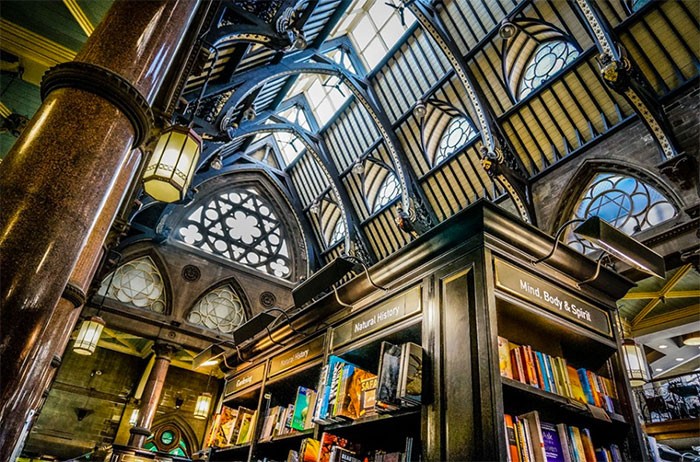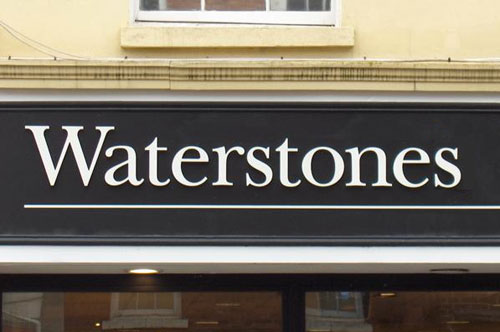 Since 2008, the retail sector has been hit time and time again as well loved stores have succumbed to the financial crash. With major retail outlets such as Woolworths, Virgin and Borders collapsing and disappearing from the high street in the UK, it seems that entertainment stores are reducing more quickly than others.
Since 2008, the retail sector has been hit time and time again as well loved stores have succumbed to the financial crash. With major retail outlets such as Woolworths, Virgin and Borders collapsing and disappearing from the high street in the UK, it seems that entertainment stores are reducing more quickly than others.
With this in mind, we sat down with Kate McHale, responsible for purchasing in the SFF, teen and graphic novel sections–which includes our favourite genre–at Waterstones, to find out how the company has seemingly ridden out the crash of 2008 and her thoughts on the literary horror genre.
Since the crash of 2008, more and more companies have gone out of business, including Borders. How has Waterstones managed to keep afloat?
KM: It’s been a tough time for lots of businesses, and particularly those on the high street. We were very lucky to find a new owner at a crucial time, but since then it’s taken a lot of hard work and some very difficult choices to turn things around. Most of this has been around improving our shops (even opening new ones) and giving our booksellers greater freedom about how the shops look and which books they want to promote.
In a world where customers can buy any book they want from Amazon, and a lot of the time can buy it very cheaply second hand, how does Waterstones cope against this kind of online business model?
KM: A great bookshop is all about discovery, which is something you just can’t replicate online. So we’ve dedicated ourselves to making our bookshops enjoyable places to be, and to really focussing on the books themselves and making sure we’re always supporting a wide range of the most interesting titles.
How does Waterstones decide on what titles to stock, both in branches and online? Is it a case of publisher involvement?
KM: We work closely with publishers, but none of our promotions are paid for so all the books we stock and the ones we really champion are always chosen by us: partly by buyers, but also by our booksellers. It means that each of our branches is different–you’ll find the bestsellers and the classic titles, but also a lot of things chosen specifically for that shop.
How do you personally choose which horror titles to stock?
KM: In horror I look for a great premise first of all, and it’s also got to be compellingly written. It’s also important that it’s got a really good jacket–something that will catch the eye in store.
The horror sections in Waterstones branches appear to be smaller than other fantastical genres, such as sci-fi and fantasy. Is that because of demand or is it a company choice?
KM: Horror is actually unique in that it has its own dedicated section, whereas others, including fantasy and science fiction, are shelved together. Generally fewer titles are published specifically in horror than across the rest of SF&F so it makes sense that it has smaller sections, but I think it’s great to be able to have this specialist space for the genre.
Do you think that customers’ tastes are more set towards other genres, rather than horror?
KM: Horror has always had a really dedicated fanbase, but I think the huge mainstream success of things like The Walking Dead also show that there’s plenty of appetite for the genre. I also think that although some people read exclusively in one genre, there are a lot of readers who really just want something good and are happy to read widely to find it! For example, one of the biggest books of the summer was the paperback of the brilliantly haunting The Loney by Andrew Michael Hurley (originally published as a limited release by Tartarus Press in 2014).
Do you feel that, especially considering the events of this year–Brexit and President Trump–that there is a mindset that things could go wrong and that this could push more readers into the horror genre?
 KM: Possibly! Although some have speculated that actually the opposite is true–that when times are harder or more uncertain we increasingly seek escapism, so there’s actually an upsurge in genres like romance. I don’t know if that’s entirely true either, but I do suspect that we’ll all need something to take us away from the news cycle now and then, and luckily a good book is a very easy place to get lost in.
KM: Possibly! Although some have speculated that actually the opposite is true–that when times are harder or more uncertain we increasingly seek escapism, so there’s actually an upsurge in genres like romance. I don’t know if that’s entirely true either, but I do suspect that we’ll all need something to take us away from the news cycle now and then, and luckily a good book is a very easy place to get lost in.
Do you think that interest in horror is growing or waning?
KM: I can’t see it ever really waning to be honest. I think there will always be that part of us that fears the thing in the dark, and we’ll always want to tell each other stories to confront it.
Some of your branches have had in-house readings from some horror authors, including David Moody and Wayne Simmons. Is this something that the company actively encourages?
KM: Yes, we love hosting events! We have a varied events programme across our shops; from festivals and big venue events, right through to readings and book groups, and most of these are organised by the teams in the shops. We’re always happy for authors to get in touch with their local store if they are keen to do events.
 In the lead up to Halloween, does Waterstones push horror titles more than the rest of the year?
In the lead up to Halloween, does Waterstones push horror titles more than the rest of the year?
KM: There is usually a surge in October and though Halloween is of course partly to do with this, I also think that it’s the change in the season more generally. You can see a definite increase in horror sales with that first cold week of the autumn and I think that settling in with something scary when the weather turns is a source of great pleasure for a lot of people! Our shops also have the freedom to focus on what suits them, so there are a number who do things like hosting Halloween book groups, or supporting All Hallows Read with displays in store. There’s also long been an association with ghost stories at Christmas, so we find that classic authors like M.R. James and (naturally) Dickens are especially popular at this time.
Waterstones stocks the obvious horror authors, such as Stephen King, Anne Rice et al, but there are a lot of independent publishers out there that stock a very interesting range of horror novels and novellas. Would Waterstones be willing to look into these indies and consider stocking something besides the prescribed norm?
KM: Actually we stock books from hundreds of publishers across the different categories, both big and small, and are always keen to find and support new ones. If a publisher is not already represented by a sales agency then what we need is for them to get in touch with us directly. There is information on our website, including an option to submit specific titles, or you can contact our Independent Publisher Coordinator at ipc@waterstones.com. I’d love to hear from more specialist horror publishers, so please do get in touch!
What are Waterstones’ future plans for the genre?
KM: We’ll be looking for new ways to support the genre and make the sections interesting. For example, our flagship at Piccadilly Circus recently sourced a selection of original editions for their horror section from authors like Ramsay Campbell, Anne Rice and Poppy Z. Brite , including many signed ones, and has put in a big display on the fiction floor. This has been a great addition to the section, and it’s always fun to try something a bit different.
And finally, what do you think is the best-selling horror title that Waterstones has stocked?
KM: I’d say it’s got to be The Shining!
J.D. GILLAM









